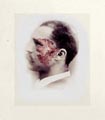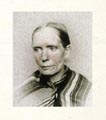



New York : E.B. Treat, [1879-]80. 2nd printing: 1881.
4 p. l., 7-102 p. 48 col. pl.
Illustrated: 48 hand colored artotypes.
Issued as 12 fascicles.
Photographer: O. G. Mason.
32 x 26 cm.
Subject: dermatology.
Cordasco 80-2136.
Shelly Crissey 324.
Pusey 147.
GM 3996: "Fox, who was professor of dermatology in New York,
produced a valuable atlas of skin diseases."
Other Editions:
Photographic Illustrations of Skin Diseases. Second Series.
New York, E.B. Treat, 1886
(copyright states 1879 and 1885); 2nd printing 1887;
3rd printing 1888; 4th printing 1889; 5th printing 1890;
6th printing 1892.
Photographic Atlas of the Diseases of the Skin.
A series of 80 plates, comprising 100 illustrations photographed
from life and colored by hand. New York, Willan; London, D.
Appleton, 1897.
Iconographie photographique des maladies de la peau. Paris,
Baillière; 1882. 96p.
Please also read John Wood's preface to his book of poems, Diseases of the Skin for more information about O. G. Mason and George Henry Fox.
This was not the first photographic atlas of cutaneous diseases to be published, that honor probably goes to Balmanno Squire for his three part series, Photographs of the Diseases of the Skin published in 1865. Squire was soon followed by Dr.s Hardy and Montmeja in Paris with skin fascicles they began to publish in 1867 and bound together for the first time in 1868. Fox was also preceded by Howard Franklin Damon of Boston with his 1870 volume Photographs of Skin Diseases and there were others who earlier seized on the idea that photographic illustrations would be of immense value for the classification of dermatological maladies. However because of the expense and time required to print and mount albumen photographs, all of these antecedents were limited to editions of a few hundred or less. With the advantage of the cheaper and larger edition runs of artotype reproduction, George Henry Fox could publish for a wider audience and so his Photographic Illustrations of Skin Diseases is important in the medical canon for the clarity and dissemination of its illustrations.
Besides the enhanced size of O. G. Mason's photographs, Fox also procured the skills of Dr. Joseph Gaertner for detailed coloring of each individual plate. This was a natural alliance between colleagues, Gaertner was tutored by the great Ferdinand von Hebra and Fox would have welcomed the chance to compare notes he took during the time when he was in Vienna for post-intern studies under Hebra and other great Wiener men of medical science including Arlt and Rokitansky.
Fox also formed an early alliance with Henry Piffard and his first publication is a book he co-wrote with Piffard entitled Cutaneous and Venereal Memoranda (1877). Their friendship lasted over forty years and must have been a rivalry that was understood by both men to be of mutual benefit. A devoted amateur photographer, Piffard is recognized as the father of flash photography and used the invention to promote his own photographic atlas of skin diseases entitled Diseases of the Skin which he published in 1891. It poses an interesting speculation to ask if Fox might have introduced Piffard to O. G. Mason, especially in light of the fact that both men got involved in New York City social reform with their photography, Mason with the images he provided for Helen Campbell's book Darkness and Daylight (1892) and Dr. Piffard for the assistance he gave Jacob Riis on his newspaper article, Flashes from the Slums (1887). In both instances the photographs were transposed into line drawings.
Not long after the appearance of his skin atlas, George Henry Fox published a syphilology atlas entitled Photographic Illustrations of Cutaneous Syphilis (1881).
















